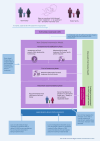Infant mental health services for birth and foster families of maltreated pre-school children in foster care (BeST?): a cluster-randomized phase 3 clinical effectiveness trial
- PMID: 40312587
- PMCID: PMC12092239
- DOI: 10.1038/s41591-025-03534-9
Infant mental health services for birth and foster families of maltreated pre-school children in foster care (BeST?): a cluster-randomized phase 3 clinical effectiveness trial
Abstract
Children entering foster care are at high risk of poor mental health. In this single-blind, cluster-randomized phase 3 trial, 382 families with 488 0-5-year-old children, entering foster care, were randomized to the New Orleans Intervention Model (NIM) or social work services as usual (SAU). NIM offers infant mental health assessment (~3 months) and treatment (6-9 months) to children and to their birth and foster families, aiming to improve child mental health and recommend return home or adoption. The principal outcome was child mental health, as measured by the Strengths and Difficulties Questionnaire Total Difficulties (SDQ-TD) scale at 2.5 years after study entry. In total, 286 families (149 NIM and 137 SAU, 367 children) were followed-up (79.4%). Intention-to-treat analysis found no intervention effect of NIM: mean (s.d.) SDQ-TD NIM, 11.5 (7.6); SAU, 11.1 (7.2); adjusted mean difference (NIM - SAU), 1.4; 95% confidence interval (-0.63, 3.53); P = 0.17. No within-trial effects for primary or secondary outcomes were observed. Despite its components being delivered to a high standard, the UK legal context surrounding NIM led to it being impossible to deliver to all eligible families, and less than 70% of families received the intervention to which they were randomized. Future research will be required to evaluate NIM in more favorable social and legal contexts. ClinicalTrials.gov registration: NCT02653716 .
© 2025. The Author(s).
Conflict of interest statement
Competing interests: None of the authors have competing interests.
Figures



Similar articles
-
The Best Services Trial (BeST?): a cluster randomised controlled trial comparing the clinical and cost-effectiveness of New Orleans Intervention Model with services as usual (SAU) for infants and young children entering care.Trials. 2022 Feb 7;23(1):122. doi: 10.1186/s13063-022-06007-3. Trials. 2022. PMID: 35130937 Free PMC article. Clinical Trial.
-
Protocol for the economic evaluation of a complex intervention to improve the mental health of maltreated infants and children in foster care in the UK (The BeST? services trial).BMJ Open. 2018 Mar 14;8(3):e020066. doi: 10.1136/bmjopen-2017-020066. BMJ Open. 2018. PMID: 29540420 Free PMC article. Clinical Trial.
-
Clout or doubt? Perspectives on an infant mental health service for young children placed in foster care due to abuse and neglect.Child Abuse Negl. 2017 Oct;72:184-195. doi: 10.1016/j.chiabu.2017.07.012. Epub 2017 Aug 17. Child Abuse Negl. 2017. PMID: 28822253 Clinical Trial.
-
Folic acid supplementation and malaria susceptibility and severity among people taking antifolate antimalarial drugs in endemic areas.Cochrane Database Syst Rev. 2022 Feb 1;2(2022):CD014217. doi: 10.1002/14651858.CD014217. Cochrane Database Syst Rev. 2022. PMID: 36321557 Free PMC article.
-
Interventions to improve mental health and well-being in care-experienced children and young people aged less than 25: the CHIMES systematic review.Public Health Res (Southampt). 2024 Dec;12(14):1-124. doi: 10.3310/MKYP6299. Public Health Res (Southampt). 2024. PMID: 39641478
Cited by
-
Economic evaluation of a complex intervention to improve the mental health of maltreated children in foster care (BeST? Services trial).J Public Health (Oxf). 2025 Aug 29;47(3):478-486. doi: 10.1093/pubmed/fdaf038. J Public Health (Oxf). 2025. PMID: 40188478 Free PMC article. Clinical Trial.
-
The quandary of high-quality evaluation in complex child welfare systems.Nat Med. 2025 May;31(5):1406-1407. doi: 10.1038/s41591-025-03643-5. Nat Med. 2025. PMID: 40312588 No abstract available.
References
-
- Turner, F. et al. ‘I will commit to this child as much as I can for the time that they are with me’: a qualitative examination of how foster carer commitment relates to short-term foster care for young children following abuse and neglect. Child Abuse Negl.135, 105983 (2023). - PubMed
-
- Hood, R. et al. Exploring drivers of demand for child protection services in an English local authority. Child Family Social Work25, 657–664 (2020).
-
- Gupta, A. Punishing the poor? Child welfare and protection under neoliberalism. Soc. Work & Soc.16(2), 1–8 (2018).
-
- Minnis, H. et al. Prioritising early childhood to promote the nation’s health, wellbeing and prosperity. https://acmedsci.ac.uk/file-download/16927511 (Academy of Medical Sciences, 2024).
-
- Bezeczky, Z. et al. Intensive Family Preservation Services to prevent out-of-home placement of children: a systematic review and meta-analysis. Child Abuse Negl.102, 104394 (2020). - PubMed
Publication types
MeSH terms
Associated data
Grants and funding
LinkOut - more resources
Full Text Sources
Medical

